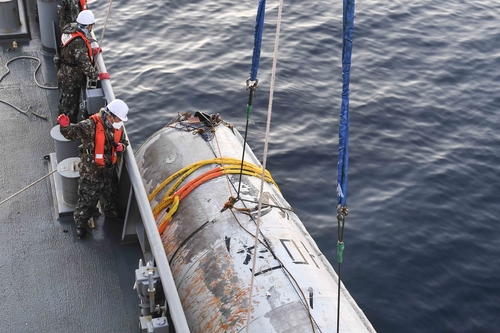 |
| ▲ South Korean military officials conduct a salvage operation to retrieve a sunken part of a North Korean space rocket from the Yellow Sea on June 15, 2023, in this photo provided by the Joint Chiefs of Staff the next day. (PHOTO NOT FOR SALE) (Yonhap) |
 |
| ▲ A sunken part of a North Korean space rocket salvaged by the South Korean military from the Yellow Sea on June 15, 2023, is seen in this photo provided by the Joint Chiefs of Staff the next day. (PHOTO NOT FOR SALE) (Yonhap) |
(2nd LD) N Korean rocket-retrieval
(2nd LD) S. Korean military salvages sunken N. Korean space rocket wreckage
(ATTN: UPDATES with more explanation from military throughout)
By Song Sang-ho and Chae Yun-hwan
SEOUL, June 16 (Yonhap) -- The South Korean military has retrieved a sunken part of an ill-fated North Korean space rocket from the Yellow Sea, officials said Friday, capping a weekslong salvage operation hamstrung by poor underwater visibility, fast currents and other obstacles.
It raised the wreckage, presumed to be the second stage of the rocket, at 8:50 p.m. Thursday, the Joint Chiefs of Staff (JCS) said, amid expectations that a probe into it could shed light on the progress of the North's long-range rocket development program.
On May 31, the North fired what it claimed to be the new "Chollima-1" rocket carrying a military reconnaissance satellite, "Malligyong-1," but it crashed into the sea due to the abnormal starting of the second-stage engine, according to its state media.
On the same day, the South Korean military identified the wreckage when it splashed into the waters some 200 kilometers west of the western island of Eocheong. But it dropped to the sea floor at a depth of 75 meters due in part to its heavy weight.
The wreckage is around 12 meters long and 2-3 meters in diameter. The South Korean military had initially assessed that it could be around half the length of the entire rocket, raising expectations that an analysis of it could help elucidate how far North Korea's rocket technology has come.
One of the photos released by the JCS showed the salvaged wreckage labeled "Cheonma," which means heavenly horse in Korean.
For the retrieval operation, the Navy deployed a group of specially trained divers and some 10 vessels, including two salvage and rescue ships, the ROKS Tongyeong and the ROKS Gwangyang, as well as the ROKS Cheonghaejin submarine rescue ship and a P-3 maritime patrol aircraft.
The painstaking operation was fraught with a set of challenges, including inclement underwater conditions, like visibility of just 50 centimeters, as the Navy prioritized the safety of divers and other personnel, according to a JCS official.
The retrieval process proceeded in phases.
Divers first attached pieces of hauling gear to the cylinder-shaped wreckage and linked it to steel wires. Before it was lifted close to the surface, divers added additional pieces of equipment to ensure it would not fall back down. Then, they hauled it onto a military ship, using a crane.
Challenges emerged from the initial phase as divers could hardly find parts of the round-shaped wreckage's exterior where they could fix wires -- unlike the uneven exterior of the crashed helicopter salvaged last year.
The military involved experts from the state-run Agency for Defense Development and other specialists in the operation to ensure it would proceed safely without losing any crucial pieces of the wreckage, the JCS official said.
Among the hindrances were the heavy weight of the wreckage stuck in the mud flat and the possibility that it could break apart while being lifted. Concerns also arose that an explosion could occur if it contained combustible elements like a fuel storage part.
"Due to the potential dangers, we had technical advisers on board so that we could take necessary steps while observing the situation," the JCS official told reporters on condition of anonymity. "From the thickness of diving suits to other issues, we sufficiently took safety concerns into account."
The salvaged part has been transported to the Navy's Second Fleet in Pyeongtaek, 60 kilometers south of Seoul.
South Korea and the United States plan to conduct a joint probe into it as agreed on during the allies' defense ministerial talks on the margins of an annual security forum in Singapore earlier this month.
Along with the salvage operation, the military is carrying out a separate mission to search for other rocket parts, including the third stage and a purported satellite. Their search has been proceeding at sea, underwater and in the air, the JCS said.
The military also retrieved another ring-shaped object presumed to be part of the rocket on June 5 at another location, a military official told reporters on condition of anonymity, without providing details of the location.
(END)
(C) Yonhap News Agency. All Rights Reserved


































